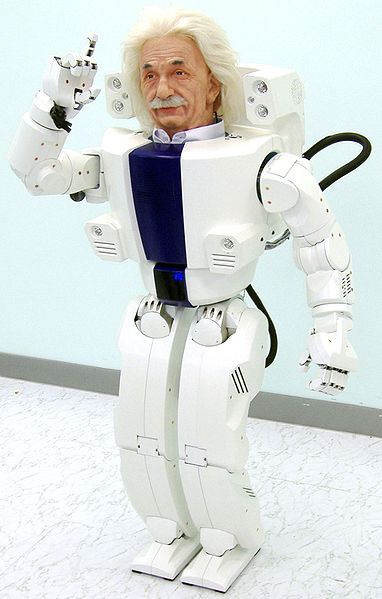
HUBO (휴보
KHR-3) is a walking humanoid robot, head mounted on a life-size walking bipedal frame,
developed by the Korea
Advanced Institute of Science and Technology(KAIST) and released on January
6, 2005. Hubo is short form for "humanoid robot."
Hubo has voice recognition and synthesis faculties, as well
as sophisticated vision in which its two eyes move independently of one another.
Korea's history in robotics engineering is relatively short.
KAIST only began research in 2000, led by professor Oh Jun-ho. The first prototype,
KHR-0, consisting of two legs without an upper body was built by 2001. KHR-1 was
developed without a head or hands released in 2003, followed by a complete
humanoid KHR-2 in
2004.[1]
On January 25, 2005, Gizmag reported on KAIST's unveiling of
the KHR-3 HUBO.[2]
The KHR-3's physical specifications, such as height, weight,
and the number of DOFs (degrees of freedom), were similar to Honda's ASIMO,
which served as the benchmark for the project. In terms of AI and movements,
HUBO fell short of the "next-gen ASIMO," which was unveiled three
months later. While HUBO could only walk at 1.25 km/h, the ASIMO could
walk at 2.5 km/h and also run at 3 km/h . The ASIMO was also capable of
walking up and down stairs, which was a temporary shortcoming for HUBO needing
further development. The unnerved KAIST researchers noted, however, that HUBO
could play kai-bai-bo (the Korean version of rock-paper-scissors), which was impossible for
ASIMO since its fingers could not move independently of each other.[1]
On November
of '05, KAIST, Korea and Dallas , Texas based
Hanson Robotics, Inc (HRI) released the world's first android head mounted on a
life-size walking bi-pedal frame at the APEC Summit in Seoul , Korea
The humanoid prototype was officially dubbed "Albert Einstein Hubo".

Jaemi HUBO was developed from 2008 to 2009. The complete
humanoid robot was given a slimmer design with an aluminum endoskeleton and a
polycarbonate frame, resulting in a slightly taller height but a 20% lighter
weight than its predecessors. Its movements were more realistic since the arms
made quicker and more natural motions, and the legs could stretch to imitate
human walking, which also consumes less energy than the traditional humanoid
walking based on the Zero
Moment Point trajectory. Its walking speed was improved to
1.4 km/h, and it also acquired the ability to run at 3.6 km/h (which
is still much slower than the new ASIMO's 6 km/h by
comparison).[1]

|
|
KHR-0
(2001) |
KHR-1
(2002) |
KHR-2
(2004) |
HUBO (KHR-3)
(2005) |
Albert HUBO
(2005) |
HUBO 2 (KHR-4)
(2008) |
|
Weight
|
|
|
|
|
|
|
|
Height
|
|
|
|
|
|
|
|
Walking speed
|
-
|
1.0 km/h
|
1.2 km/h
|
1.25 km/h
|
1.25 km/h
|
1.5 km/h
|
|
Continuous operating
time
|
-
|
-
|
-
|
60 minutes
|
60 minutes
|
120 minutes
|
|
12
|
21
|
41
|
41
|
66
|
40
|
No comments:
Post a Comment